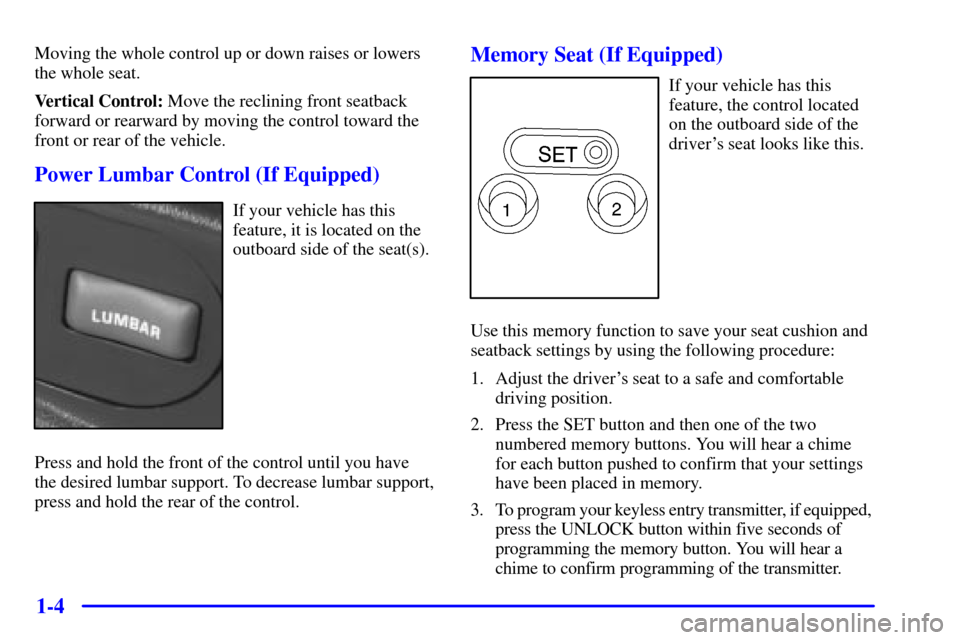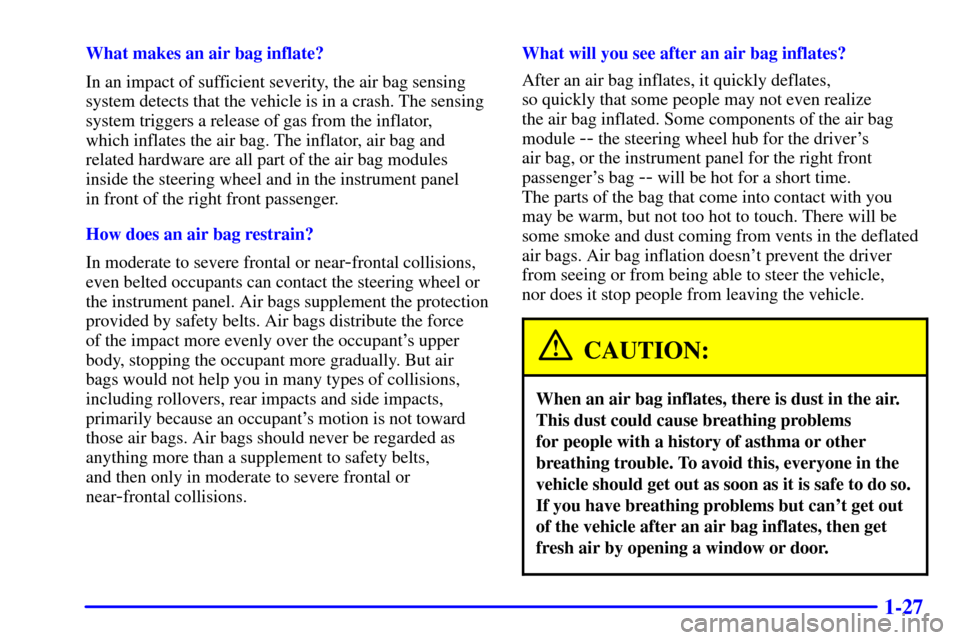Page 2 of 448
Courtesy
Transportation
Every
2001 Blazer
under warranty is
backed with the
following
services:1-800-CHEV-USA
(For vehicles purchased in Canada,
call
1-800-268-6800)
that provides in an emergency:
Free lockout assistance
Free dead-battery assistance
Free out-of-fuel assistance
Free flat-tire change
Emergency towing
®
1-800-CHEV-USA
(For vehicles purchased in Canada,
call
1-800-268-6800)
Page 5 of 448
Comfort Controls and Audio Systems
Your Driving and the Road
Table of Contents (cont'd)
Your Driving, the Road and Your Vehicle
Defensive Driving
Drunken Driving
Control of a Vehicle
Braking
SteeringDriving Tips for Various Road Conditions
Off-Road Driving
Recreational Vehicle Towing
Loading Your Vehicle
Towing a Trailer Heating and Air Conditioning
Setting the Radio Clock
Radio/Cassette Player/CD PlayerRadio Theft-Deterrent Feature
Steering Wheel Controls (If Equipped)
Hazard Warning Flashers
Jump Starting
Towing Your VehicleEngine Overheating
Changing a Flat Tire
If You're Stuck
Problems on the Road
iii
Section
5
Section
4
Section
3
Page 15 of 448
1-3 Manual Lumbar Support (If Equipped)
If your vehicle has this
feature, there will be a knob
on the outboard side of the
driver's and passenger's
bucket seats.
Turn the knob counterclockwise to increase lumbar
support and clockwise to decrease lumbar support.
Power Seats (If Equipped)
If your vehicle has this feature, there will be a control on
the outboard side of your seat.
Horizontal Control: Raise or lower the front of the
seat by raising or lowering the forward edge of
the control.
Raise or lower the rear of the seat by raising or lowering
the rear edge of the control. Move the seat forward or
rearward by moving the whole control toward the
front or the rear of the vehicle.
Page 16 of 448

1-4
Moving the whole control up or down raises or lowers
the whole seat.
Vertical Control: Move the reclining front seatback
forward or rearward by moving the control toward the
front or rear of the vehicle.
Power Lumbar Control (If Equipped)
If your vehicle has this
feature, it is located on the
outboard side of the seat(s).
Press and hold the front of the control until you have
the desired lumbar support. To decrease lumbar support,
press and hold the rear of the control.
Memory Seat (If Equipped)
If your vehicle has this
feature, the control located
on the outboard side of the
driver's seat looks like this.
Use this memory function to save your seat cushion and
seatback settings by using the following procedure:
1. Adjust the driver's seat to a safe and comfortable
driving position.
2. Press the SET button and then one of the two
numbered memory buttons. You will hear a chime
for each button pushed to confirm that your settings
have been placed in memory.
3. To program your keyless entry transmitter, if equipped,
press the UNLOCK button within five seconds of
programming the memory button. You will hear a
chime to confirm programming of the transmitter.
Page 39 of 448

1-27
What makes an air bag inflate?
In an impact of sufficient severity, the air bag sensing
system detects that the vehicle is in a crash. The sensing
system triggers a release of gas from the inflator,
which inflates the air bag. The inflator, air bag and
related hardware are all part of the air bag modules
inside the steering wheel and in the instrument panel
in front of the right front passenger.
How does an air bag restrain?
In moderate to severe frontal or near
-frontal collisions,
even belted occupants can contact the steering wheel or
the instrument panel. Air bags supplement the protection
provided by safety belts. Air bags distribute the force
of the impact more evenly over the occupant's upper
body, stopping the occupant more gradually. But air
bags would not help you in many types of collisions,
including rollovers, rear impacts and side impacts,
primarily because an occupant's motion is not toward
those air bags. Air bags should never be regarded as
anything more than a supplement to safety belts,
and then only in moderate to severe frontal or
near
-frontal collisions.What will you see after an air bag inflates?
After an air bag inflates, it quickly deflates,
so quickly that some people may not even realize
the air bag inflated. Some components of the air bag
module
-- the steering wheel hub for the driver's
air bag, or the instrument panel for the right front
passenger's bag
-- will be hot for a short time.
The parts of the bag that come into contact with you
may be warm, but not too hot to touch. There will be
some smoke and dust coming from vents in the deflated
air bags. Air bag inflation doesn't prevent the driver
from seeing or from being able to steer the vehicle,
nor does it stop people from leaving the vehicle.
CAUTION:
When an air bag inflates, there is dust in the air.
This dust could cause breathing problems
for people with a history of asthma or other
breathing trouble. To avoid this, everyone in the
vehicle should get out as soon as it is safe to do so.
If you have breathing problems but can't get out
of the vehicle after an air bag inflates, then get
fresh air by opening a window or door.
Page 54 of 448
1-42
Restraint Systems for Children
An infant car bed (A), a special bed made for use in a
motor vehicle, is an infant restraint system designed to
restrain or position a child on a continuous flat surface.
Make sure that the infant's head rests toward the center
of the vehicle.
A rear-facing infant seat (B) provides restraint with
the seating surface against the back of the infant.
The harness system holds the infant in place and, in a
crash, acts to keep the infant positioned in the restraint.
Page 66 of 448
1-54
CAUTION:
Never do this.
Here two children are wearing the same belt.
The belt can't properly spread the impact forces.
In a crash, the two children can be crushed
together and seriously injured. A belt must be
used by only one person at a time.
Q:What if a child is wearing a lap-shoulder belt,
but the child is so small that the shoulder belt is
very close to the child's face or neck?
A:Move the child toward the center of the vehicle,
but be sure that the shoulder belt still is on the
child's shoulder, so that in a crash the child's upper
body would have the restraint that belts provide.
If the child is sitting in a rear outside position of a
four
-door model, see ªRear Safety Belt Comfort
Guidesº in the Index. If the child is so small that
the shoulder belt is still very close to the child's
face or neck, you might want to place the child in
a seat that has a lap belt, if your vehicle has one.
Page 77 of 448

2-9
Your vehicle left the factory programmed to have no
doors lock and none of the doors unlock. You can set the
automatic lock feature to lock all the doors when the
vehicle speed is greater than 15 mph (24 km/h) for
two seconds, and then unlock all the doors once the key
is removed from the ignition. The following instructions
detail how to program your door locks differently than
the factory setting. Choose one of the four programming
options listed above before entering the program mode.
To enter the program mode you need to do the following:
1. Begin with the ignition in OFF. Then pull the turn
signal/multifunction lever toward you and hold it
there while you perform the next step.
2. Turn the key to RUN and OFF twice. Then, with the
key in OFF, release the turn signal/multifunction
lever. Once you do this, you will hear the lock switch
lock and unlock and a 30 second program timer
will begin.3. You are now ready to program the automatic
door locks. Select one of the four programming
options listed above, and follow the instructions.
You will have 30 seconds to begin programming.
If you exceed the 30 second limit, the locks will
automatically lock and unlock to indicate that you
have left the program mode. If this occurs, repeat the
procedure beginning with Step 1.
You can exit the program mode any time by turning the
ignition to RUN (the locks will automatically lock and
unlock to indicate that you are leaving the program mode).
If the lock/unlock switches are not pressed while in the
programming mode, the current auto lock/unlock setting
will not be modified.
See your dealer for more information.